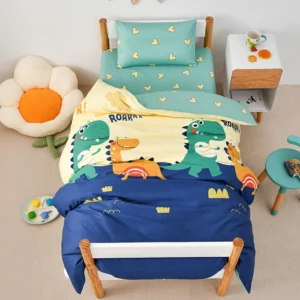When buying baby bedding, it’s important to prioritize safety, comfort, and practicality.
Here are some key points to pay attention to:
- Safety Standards: Ensure that the baby bedding meets safety standards set by your country or region. Look for certifications such as the JPMA (Juvenile Products Manufacturers Association) seal or compliance with international safety standards.
- Crib Fit: The bedding should fit snugly and securely in the crib without any loose or hanging fabric that could pose a suffocation or entanglement hazard. Use fitted sheets designed specifically for cribs and avoid using blankets, pillows, or stuffed toys in the crib.
- Material: Choose bedding made from breathable and hypoallergenic materials, such as cotton or organic cotton. These materials are gentle on a baby’s sensitive skin and allow for proper airflow.
- Softness: Opt for bedding that is soft and comfortable for your baby. Prioritize smooth fabrics and avoid rough or scratchy materials that may irritate their delicate skin.
- Easy Maintenance: Select bedding that is easy to clean and maintain. Look for machine-washable and dryer-safe options to ensure convenience and hygiene.
- Waterproof Features: Consider using a waterproof mattress cover or protector to prevent liquids from seeping through to the mattress. This helps with easy cleanup and protects the mattress from stains and odors.
- Temperature Regulation: Choose bedding that provides appropriate insulation for the season and temperature of your baby’s sleeping environment. Consider using lightweight blankets or sleep sacks to keep your baby comfortable without overheating.
- Design and Decor: While aesthetics are not the primary concern, you can still choose bedding with attractive designs and colors that complement the nursery decor. However, avoid bedding with excessive embellishments or decorative elements that could pose a safety risk.
- Reviews and Recommendations: Read reviews and seek recommendations from other parents or trusted sources to learn about their experiences with different baby bedding brands and products. Their insights can provide valuable information and help you make an informed decision.
- Purchase from Reputable Sources: Buy baby bedding from reputable retailers or manufacturers to ensure quality and authenticity. Avoid purchasing used bedding, as it may not meet current safety standards or may have potential hygiene issues.
Remember to follow safe sleep practices recommended by pediatricians, such as placing babies on their backs to sleep and keeping the crib free of loose bedding, pillows, baby set bedding and stuffed animals. Prioritizing safety and comfort will help provide a cozy and secure sleeping environment for your little one.
Here are some additional points to consider when buying baby bedding:
- Breathability: Choose bedding that promotes good airflow to reduce the risk of overheating and ensure that your baby can breathe easily. Look for bedding with breathable fabrics and avoid heavy or overly thick materials.
- Sizing: Ensure that the bedding fits the specific size of your baby’s crib or bassinet. Use fitted sheets that securely cover the mattress without any loose edges that could pose a suffocation hazard.
- Firmness: Opt for a firm mattress for your baby’s crib or bassinet. This helps provide a safe sleeping surface and reduces the risk of Sudden Infant Death Syndrome (SIDS).
- Age Appropriateness: Consider the age of your baby when choosing bedding. For newborns, it’s best to keep the crib bare except for a fitted sheet. As your baby grows older and starts using blankets or sleep sacks, ensure they are age-appropriate and safe.
- Allergies and Sensitivities: If your baby has known allergies or sensitivities, choose hypoallergenic bedding materials and avoid products with potential allergens such as down feathers.
- Coordination with Sleepwear: Consider how the bedding coordinates with your baby’s sleepwear. For example, if you use sleep sacks, ensure that the bedding allows for easy fitting and is not too restrictive.
- Easy Accessibility: Choose bedding that is easy to put on and remove for cleaning. Look for bedding that has elasticized edges or zippers for hassle-free use.
- Multiple Sets: It’s a good idea to have multiple sets of bedding on hand so that you can easily rotate them for cleaning. This ensures that your baby always has a fresh and clean sleeping environment.
- Certifications: Look for baby bedding that is certified by reputable organizations such as Oeko-Tex Standard 100, which ensures that the product is free from harmful substances.
- Personal Style: While safety and functionality are paramount, you can still select baby bedding that reflects your personal style and complements the overall nursery decor. Consider colors, patterns, and themes that you find appealing.
Remember, the most important factors when buying baby bedding are safety, comfort, and practicality. By considering these additional points, you can make a well-informed decision and create a comfortable and secure sleeping environment for your baby.
